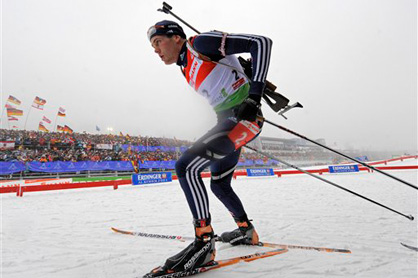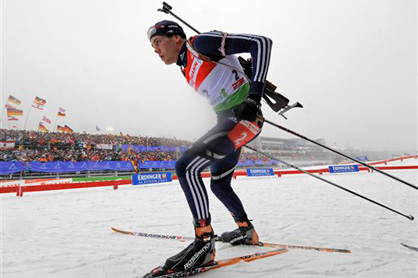To prepare for the Winter Olympics in Sochi, Russia which begin on February 6, 2014, Dear Sports Fan is running a series of previews of Winter Olympics events. So far we’ve profiled the Luge, Skeleton, Bobsled, Ice Hockey, and Cross-Country Skiing.
All About Biathlon
- It doesn’t get much better or more pure than the Biathlon in the Winter Olympics. The Biathlon is an event that combines a brutal endurance sport with a highly technical one; cross-country skiing with riflery. If the Olympic sports we’ve profiled so far are extreme versions of sledding (Luge, Skeleton, and Bobsled) and just getting around (Cross-Country Skiing,) Biathlon is the first of another category of Olympic sports: tamed versions of war. In the same way that the Summer Olympic sports of Boxing and Judo are tamed down versions of hand-to-hand combat and Fencing is a safe way to practice sword-fighting, biathlon tests skills required in (only slightly) antiquated fighting in snow-covered, mountainous areas. Ski and shoot and then ski some more. If you’re still alive at the end of the day, you could win a Gold medal.
-

Ski, ski, ski, breath, shoot, repeat. How Does the Biathlon Work?
- To excel at the Biathlon, biathletes must ski as hard and as fast as they can with a rifle strapped to their back, stop, and again as fast but also as accurately at possible, shoot their rifle and hit a very, very small target. In each race, competitors will shoot from various positions: either lying down or standing up. The targets are 160 feet away and for the prone (lying down) shots, are 1.8 inches across; for standing up they are a little bigger: 4.5 inches. The skiing distances vary from race to race but all of them are liable to induce heavy breathing. The athletes have that problem too, because heavy breathing makes it difficult to balance their rifles and make an accurate shot. A biathlete can make up for a missed shot by using one of their limited “extra cartridges,” by skiing a penalty distance, or by accepting a time penalty. In this very Who Wants to Be a Millionaire way, shooting accuracy is mixed into the score-keeping of the sport which is time-based.
- French Biathlete Marie-Laure Brunet gives an overview of the sport:
- http://www.youtube.com/watch?v=TDtg7QXNEjM
Why Do People Like Watching Biathlon?
- Delicate Balance: What happens if you’re running a few seconds behind? Do you push harder on the skiing sections? If you do, will you still be able to maintain focus and steady breathing enough to hit the rifle targets? What’s the right balance? It’s unusual and compelling to watch a sport that requires such control.
- Those Targets are Satisfying: For everyone who keeps a to-do list just to get the satisfaction of checking things off, this is the sport for you! The targets flip from black to white (or white to black, I can’t remember) when they are hit in a completely satisfying way.
- Running Around and Shooting Stuff is Fun: It’s like the acceptable precursor to paintball!!
-
What Are the Different Biathlon Events?
There are five different types of Biathlon events at the Olympics in Sochi. There are Individual events where competitors are spaced out by 30 seconds and compete against the clock. There are Sprint events which are exactly the same but about half the distance. There are Pursuit events where instead of a standard 30 seconds, biathletes are separated by the time-gap in their finish in an earlier race and the person who hits the finish line first wins. There are Mass Start events which are basically what they sound like — a chaotic start with up to 60 people sprinting on skis. With rifles. There are also Relay events where teams of four compete in sprint-like distances.
How Dangerous is the Biathlon?
Shockingly, considering EVERYONE has a gun, this is a pretty safe event. There have been some articles about the particular track in Sochi. Apparently it has a very steep turn that people feel may be dangerous to ski on. There’s also a faint whiff of intent about the curve — the suggestion being that the Russians who get to practice on that track more than other teams, have created themselves a home-track advantage. Nonetheless, it’s a very safe sport.
What’s the State of Gender Equality in Olympic Biathlon?
Biathlon is one of the most egalitarian sports we’ve profiled so far! Every event has a male and a female equivalent and there are even three Relay events, one men’s, one women’s, and one for mixed teams of two men and two women. The women’s events are still shorter than the men’s but other than that, everything is equal.
What are Some Fun Olympic Biathlon Stories?
The United States Olympic team has one half of a set of twins on it. Sister Tracy Barnes gave up her spot to her sister Lanny who she felt had missed out unfairly because of illness.
Dominance and the Opposite: The Biathlon is one of the few (maybe the only) event that the United States has never won a medal in. Norway, on the other hand, dominates the sport. Of particular interest is a 40 year old Ole Einar Bjoerndalen nicknamed “The Cannibal” who has won 11 medals in the Olympics and wants more.
The Russian Bear: The Russians are aimed at winning some Biathlon medals this year. They’ve thrown the full weight of their oligarchy behind the effort. Billionaire and Brooklyn Nets Owner Mikhail Prokhorov has been put in charge of making this happen. The New York Times’ article on the topic is a must read.
Important Links:
The official biathlon schedule.
NBC home-page for US TV information.
The Cross-Country Skiing events begin on Feb. 8 and end on Feb. 22.

